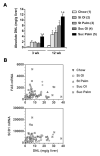Isocaloric manipulation of macronutrients within a high-carbohydrate/moderate-fat diet induces unique effects on hepatic lipogenesis, steatosis and liver injury
- PMID: 26895660
- PMCID: PMC4761406
- DOI: 10.1016/j.jnutbio.2015.10.020
Isocaloric manipulation of macronutrients within a high-carbohydrate/moderate-fat diet induces unique effects on hepatic lipogenesis, steatosis and liver injury
Abstract
Diets containing excess carbohydrate and fat promote hepatic steatosis and steatohepatitis in mice. Little is known, however, about the impact of specific carbohydrate/fat combinations on liver outcome. This study was designed to determine whether high-energy diets with identical caloric density but different carbohydrate and fat composition have unique effects on the liver. Four experimental diets were formulated with 60%kcal carbohydrate and 20%kcal fat, each in nearly pure form from a single source: starch-oleate, starch-palmitate, sucrose-oleate and sucrose-palmitate. The diets were fed to mice for 3 or 12 weeks for analysis of lipid metabolism and liver injury. All mice developed hepatic steatosis over 12 weeks, but mice fed the sucrose-palmitate diet accumulated more hepatic lipid than those in the other three experimental groups. The exaggerated lipid accumulation in sucrose-palmitate-fed mice was attributable to a disproportionate rise in hepatic de novo lipogenesis. These mice accrued more hepatic palmitate and exhibited more evidence of liver injury than any of the other experimental groups. Interestingly, lipogenic gene expression in mice fed the custom diets did not correlate with actual de novo lipogenesis. In addition, de novo lipogenesis rose in all mice between 3 and 12 weeks, without feedback inhibition from hepatic steatosis. The pairing of simple sugar (sucrose) and saturated fat (palmitate) in a high-carbohydrate/moderate-fat diet induces more de novo lipogenesis and liver injury than other carbohydrate/fat combinations. Diet-induced liver injury correlates positively with hepatic de novo lipogenesis and is not predictable by isolated analysis of lipogenic gene expression.
Keywords: Fatty liver; Palmitate; Saturated fat; Steatohepatitis; Sucrose; Sugar; Triglyceride.
Copyright © 2015 Elsevier Inc. All rights reserved.
Figures






Similar articles
-
Differential hepatotoxicity of dietary and DNL-derived palmitate in the methionine-choline-deficient model of steatohepatitis.BMC Gastroenterol. 2015 Jun 24;15:72. doi: 10.1186/s12876-015-0298-y. BMC Gastroenterol. 2015. PMID: 26103964 Free PMC article.
-
Specific Macronutrients Exert Unique Influences on the Adipose-Liver Axis to Promote Hepatic Steatosis in Mice.Cell Mol Gastroenterol Hepatol. 2017 Apr 22;4(2):223-236. doi: 10.1016/j.jcmgh.2017.04.004. eCollection 2017 Sep. Cell Mol Gastroenterol Hepatol. 2017. PMID: 28649594 Free PMC article.
-
Dietary fat intake promotes the development of hepatic steatosis independently from excess caloric consumption in a murine model.Metabolism. 2010 Aug;59(8):1092-105. doi: 10.1016/j.metabol.2009.11.006. Epub 2010 Jan 8. Metabolism. 2010. PMID: 20060143 Free PMC article.
-
Changes in fat synthesis influenced by dietary macronutrient content.Proc Nutr Soc. 2002 May;61(2):281-6. doi: 10.1079/PNS2002148. Proc Nutr Soc. 2002. PMID: 12133211 Review.
-
Role of dietary carbohydrates and macronutrients in the pathogenesis of nonalcoholic fatty liver disease.Curr Opin Clin Nutr Metab Care. 2008 Jul;11(4):477-82. doi: 10.1097/MCO.0b013e328302f3ec. Curr Opin Clin Nutr Metab Care. 2008. PMID: 18542010 Review.
Cited by
-
Dietary Macronutrient Composition Determines the Contribution of DGAT1 to Alcoholic Steatosis.Alcohol Clin Exp Res. 2018 Dec;42(12):2298-2312. doi: 10.1111/acer.13881. Epub 2018 Oct 3. Alcohol Clin Exp Res. 2018. PMID: 30192394 Free PMC article.
-
Macronutrients and the Adipose-Liver Axis in Obesity and Fatty Liver.Cell Mol Gastroenterol Hepatol. 2019;7(4):749-761. doi: 10.1016/j.jcmgh.2019.02.001. Epub 2019 Feb 11. Cell Mol Gastroenterol Hepatol. 2019. PMID: 30763771 Free PMC article. Review.
-
Beneficial Effects of Tamarind Trypsin Inhibitor in Chitosan-Whey Protein Nanoparticles on Hepatic Injury Induced High Glycemic Index Diet: A Preclinical Study.Int J Mol Sci. 2021 Sep 15;22(18):9968. doi: 10.3390/ijms22189968. Int J Mol Sci. 2021. PMID: 34576130 Free PMC article.
-
Selected Physiological Effects of a Garcinia Gummi-Gutta Extract in Rats Fed with Different Hypercaloric Diets.Nutrients. 2018 May 4;10(5):565. doi: 10.3390/nu10050565. Nutrients. 2018. PMID: 29734675 Free PMC article.
-
Male apoE*3-Leiden.CETP mice on high-fat high-cholesterol diet exhibit a biphasic dyslipidemic response, mimicking the changes in plasma lipids observed through life in men.Physiol Rep. 2017 Oct;5(19):e13376. doi: 10.14814/phy2.13376. Epub 2017 Oct 16. Physiol Rep. 2017. PMID: 29038350 Free PMC article.
References
-
- Browning JD, Szczepaniak LS, Dobbins R, Nuremberg P, Horton JD, Cohen JC, et al. Prevalence of hepatic steatosis in an urban population in the United States: impact of ethnicity. Hepatology. 2004;40:1387–95. - PubMed
-
- Charlton M, Krishnan A, Viker K, Sanderson S, Cazanave S, McConico A, et al. Fast food diet mouse: novel small animal model of NASH with ballooning, progressive fibrosis, and high physiological fidelity to the human condition. Am J Physiol Gastrointest Liver Physiol. 2011;301:G825–34. - PMC - PubMed
Publication types
MeSH terms
Substances
Grants and funding
LinkOut - more resources
Full Text Sources
Other Literature Sources
Medical

